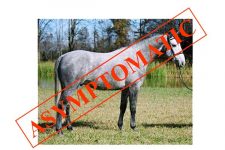
Canadian Equine Viral Arteritis!
There has been an EVA outbreak in Canada reported in Prince Edward Island. Equine Viral Arteritis is predominantly a respiratory disease, which has reproductive implications. Symptoms vary dramatically from none (“asymptomatic”) to a wide variety which may present as any combination of the following: elevated temperature, depression, loss of appetite. Affected animals may also exhibit edema in the lower limbs, especially the hind limbs, mammary glands, scrotum, sheath, around or above the eye, lethargy, stiff movement, nasal discharge, conjunctivitis (“pink eye”) and a localized or generalized skin rash.
The current EVA outbreak in Canada is in Prince Edward Island and involves multiple locations. 12 animals have been identified as being affected, of which 6 have died. Normally, while EAV (the virus is “EAV” – equine arteritis virus – and the disease is “EVA” – equine viral arteritis) infection may cause abortions, it is not fatal except in the case of debilitated animals or neonates. In this outbreak, it is the latter category of newborn foals which have died, with all the foals being less than one week in age. The cause of death has been confirmed via necropsy, where RT-PCR and virus isolation were used. These foals all showed fulminant interstitial pneumonia caused by EVA. As foals are born without immunity to (any) disease, and usually acquire their initial immunity from colostrum, if the mare has not been previously exposed to the EAV, then antibodies to the virus will not be present in the colostrum. “Prior exposure” and subsequent antibody presence may be as a result of either having had the disease, or being vaccinated against it.
As we reported in 2018, Zoetis Canada stopped production of the Equine Arteritis Vaccine “Arvac”, and supplies within the US are always variable with the vaccine often being on “backorder”. It is to be hoped that Zoetis will be able to organize a supply of the vaccine to attempt to manage this latest EVA outbreak in Canada, and discussions with that company are promising.
It is not known where the virus in this current outbreak originated, and investigative tracing is still ongoing, although the outbreak is currently considered “contained” and there are no restrictions of movement within the Province. Possible sources could include animals exposed to respiratory transfer – which given that animals can be asymptomatic could have occurred at any competition or other gathering where an infectious horse was present – or via transfer in semen. The virus is somewhat interesting in that it is the only virus in all species (not just the equine) which is dependent upon testosterone for maintenance in the body, so the stallion is the natural reservoir. Mares, once the acute stage of infection has passed do not maintain the ability to transmit the virus, the stallion however – who after the acute stage will not show any indication of infection (and may not if asymptomatic during that acute stage) – may go on to be a persistent shedder of the virus in his semen. If a mare is bred with infective semen, she herself may become infected, and although the potential pregnancy from that breeding will not be affected, other pregnant mares to which she is exposed during the acute stage of the infection may abort. Neonates – as in this current EVA outbreak in Canada – may also become infected, either from the mare that was bred, or other mares infected through exposure. At the time of breeding, the mare being bred with the infective semen may also physically shed the virus from excess semen being expelled from the vagina in the usual post-breeding clearance process. Her own and/or other foals may then come in contact with the virus at that point.
Equine Viral Arteritis is present in various populations around the world, but absent in others. The UK, Australia and New Zealand for example are free of the disease and rigorously defend their borders to prevent accidental or malicious importation. Unfortunately, North America is not free of the disease, and the US – which has free transport of equines and reproductive products with Canada (i.e. no testing required, although there are some requirements related to the CEM outbreak in the US for semen transport) – has no testing requirements for importing horses or semen from countries where the disease is present. It is also known that there are EAV-positive and shedding stallions already present in Canada.
We provide more information on the subject of EVA in an article we wrote with world-renowned expert on the subject, Dr. Peter Timoney. The article can be found by following that link. If more information about the current outbreak of EVA in Canada becomes available, we will update our news page with that information.



